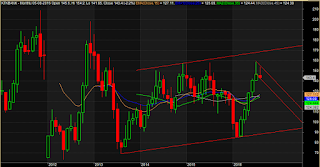Warren Buffett writes in 2010 annual report about how to
calculate the intrinsic value of Berkshire Hathway. The same approach or the
method can be adopted by us while reviewing or valuating business.
“Though Berkshire’s intrinsic value cannot be precisely
calculated, two of its three key pillars can be measured. Charlie and I rely
heavily on these measurements when we make our own estimates of Berkshire’s
value.
The first component of value is our investments: stocks, bonds
and cash equivalents. At yearend these totalled $158 billion at market value.
Insurance float – money we temporarily hold in our insurance
operations that does not belong to us – funds $66 billion of our investments. This
float is “free” as long as insurance underwriting breaks even, meaning that the
premiums we receive equal the losses and expenses we incur. Of course, underwriting
results are volatile, swinging erratically between profits and losses. Over our
entire history, though, we’ve been significantly profitable, and I also expect
us to average breakeven results or better in the future. If we do that, all of
our investments – those funded both by float and by retained earnings – can be
viewed as an element of value for Berkshire shareholders.
Berkshire’s second component of value is earnings that come
from sources other than investments and insurance underwriting. These earnings
are delivered by our 68 non-insurance companies, itemized on page 106. In
Berkshire’s early years, we focused on the investment side. During the past two
decades, however, we’ve increasingly emphasized the development of earnings
from non-insurance business, a practice that will continue.
The following table illustrate this shift. In the first
table, we present per-share investments at decade intervals beginning in 1970,
three years after we entered the insurance business. We exclude those
investments applicable to minority interests.
Yearend
|
Investments ($)
|
Period
|
Compounded Annual Increase in Per-share Investments
|
1970
|
66
|
||
1980
|
754
|
1970-1980
|
27.5%
|
1990
|
7,798
|
1980-1990
|
26.3%
|
2000
|
50229
|
1990-2000
|
20.5%
|
2010
|
94730
|
2000-2010
|
6.6%
|
Though our compounded annual increase in per-share
investments was a healthy 19.9% over the 40-year period, our rate of increase
has slowed sharply as we have focused on using funds to buy operating
businesses.
The payoff from this shift is shown in the following table,
which illustrates how earnings of our non-insurance businesses have increased,
again on a per-share basis and after applicable minority interests.
Year
|
Per-Share Pre-Tax Earnings
|
Period
|
Compounded Annual Increase in per-Share Pre-Tax Earnings
|
1970
|
2.87
|
||
1980
|
19.01
|
1970-1980
|
20.8%
|
1990
|
102.58
|
1980-1990
|
18.4%
|
2000
|
918.66
|
1990-2000
|
24.5%
|
2010
|
5926.04
|
2000-2010
|
20.5%
|
For the forty years, our compounded annual gain in pre-tax,
non-insurance earnings per share is 21.0%. During the same period, Berkshire’s
stock price increased at a rate of 22.1% annually. Over time, you can expect
our stock prices to move in rough tandem with Berkshire’s investments and
earnings. Market price and intrinsic value often follow very different paths –
sometimes for extended periods – but eventually they meet.
There is a third, more subjective, element to an intrinsic
value calculation that can be either positive or negative: the efficacy with
which retained earnings will be deployed in the future. We, as well as many
other businesses, are likely to retain earnings over the next decade that will
equal, or even exceed, the capital we presently employ. Some companies will
turn these retained dollars into fifty-cent pieces, others into two-dollar
bills.
This “what-will-they-do-with-the-money” factor must always
be evaluated along with the “what-do-we-have-now” calculation in order for us,
or anybody, to arrive at a sensible estimate of a company’s intrinsic value.
That’s because an outside investor stands by helplessly as management reinvests
his share of the company’s earnings. If a CEO can be expected to do this job
well, the reinvestment prospects ad to the company’s current value; if the CEO’s
talents or motives are suspect, today’s value must be discounted. The
difference in outcome can be huge. A dollar of then-value in the hands of Sears
Roebuck’s or Montgomery Ward’s CEOs in the late 1960s had a far different
destiny than did a dollar entrusted to Sam Walton.”
Basically Buffett is suggesting us to value the business as
three components:
1.
Investments
2.
Operational business
3.
Utilisation of retained earnings
Generally in the business that we will be evaluating, the
order of these three elements will be
1.
Operational business or income from main
operations
2.
Investments – income from investments. These
will be typically in liquid mutual funds or fixed deposits (FDs)
3.
Utilisation of the retained earnings










